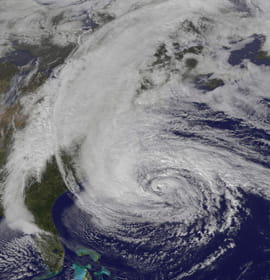Hurricane Sandy CCRUN

- Drexel Selects New, World-Class Life Sciences Building at 3201 Cuthbert Street for Medical Research Operations
- Breakthrough on Gene Therapy for Hereditary Spastic Paraplegia
- Drexel Environmental Collaboratory Releases Cross-Sector Findings on Severe Weather Recovery Challenges
- Drexel Launches the Manuel Stamatakis Center for Alternative Investments at the LeBow College of Business

As recovery efforts in the wake of Hurricane Sandy continue, experts who study climate and impacts in urban areas are looking for ways to minimize the loss of life and livelihoods the next time an extreme weather event affects east coast cities. Among the team's members, Drexel's Dr. Franco Montalto, an assistant professor in the College of Engineering, is looking at how infrastructure can be designed to minimize flooding.
The Consortium on Climate Risk in the Urban Northeast (CCRUN), a NOAA Regional Integrated Sciences and Assessment (RISA) research group with expertise in climate science, oceanography, engineering, green infrastructure, public health, and social vulnerability is monitoring the effects of climate and climate change in the region and taking a close look at the aftermath of the storm. The group will work toward a recommendation on how community resilience and disaster-response can be improved.
“Hurricane Sandy is a wake-up call for the urban Northeast,” said Cynthia Rosenzweig, a researcher from NASA’s Goddard Institute For Space Studies and the principal investigator of CCRUN. “We need to learn from it to improve resilience as climate risks increase due to climate change.”
Striking during high astronomical tide, Hurricane Sandy became what meteorologists termed a “superstorm” due to the combination of unusually warm temperatures in the North Atlantic and its interaction with another weather front moving through the eastern United States.
Tropical storm-force winds extended approximately 1,000 miles in diameter across the densely populated urban coastal areas of the Northeast. Sandy produced a storm tide -the total height of water entering New York Harbor- of almost 14 feet.
More than 100 people lost their lives during the hurricane. Initial estimates are that flooding and strong winds caused upwards of $50 billion in property damage and economic losses on the East Coast. An estimated four million people were without power in the New York metropolitan region and in New York City alone more than 20,000 people may be homeless due to property damage.
Impacts to infrastructure were crippling from New Jersey to Connecticut. Seven subway tunnels under the East River were flooded, with service out for close to a week. According to the group, the long-term impacts of the storm are still being uncovered.
“While it’s impossible to eliminate all vulnerabilities during a storm of this magnitude, one thing we can do is seek to harness new and enhanced natural green spaces including wetlands, parks, and other permeable landscape features to protect people from the next extreme weather event,” said Montalto, a co-investigator from Drexel University who is studying the interaction of the storm with regional green infrastructure networks.
CCRUN scientists at Stevens Institute of Technology used their Storm Surge Warning System to predict the storm tide to within 20 percent, aiding preparations for the flooding. The group hopes to build upon its forecasting of coastal storms and clearly identify to people living in urban areas in the northeast the flood dangers they pose.
The team will also examine ways to minimize health risks, such as polluted water sources, in the wake of storm surge flooding; and recommend infrastructural improvements that can limit the amount of flooding that occurs.
“As sea levels rise, we are going to see more coastal flooding; fortunately there are steps we can take as a society to reduce our vulnerability,” said Radley Horton, a co-investigator from Columbia University.
In addition to Rosenzweig, Montalto and Horton, CCRUN’s investigators include Alan Blumberg, from Stevens Institute of Technology; Columbia University’s Bob Chen, Patrick Kinney and Upmanu Lall; Reza Khanbilvardi, from the City College of New York; and Richard Palmer of the University of Massachusetts – Amherst.
Drexel News is produced by
University Marketing and Communications.